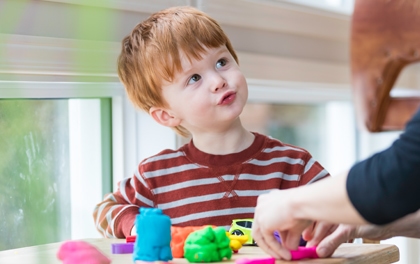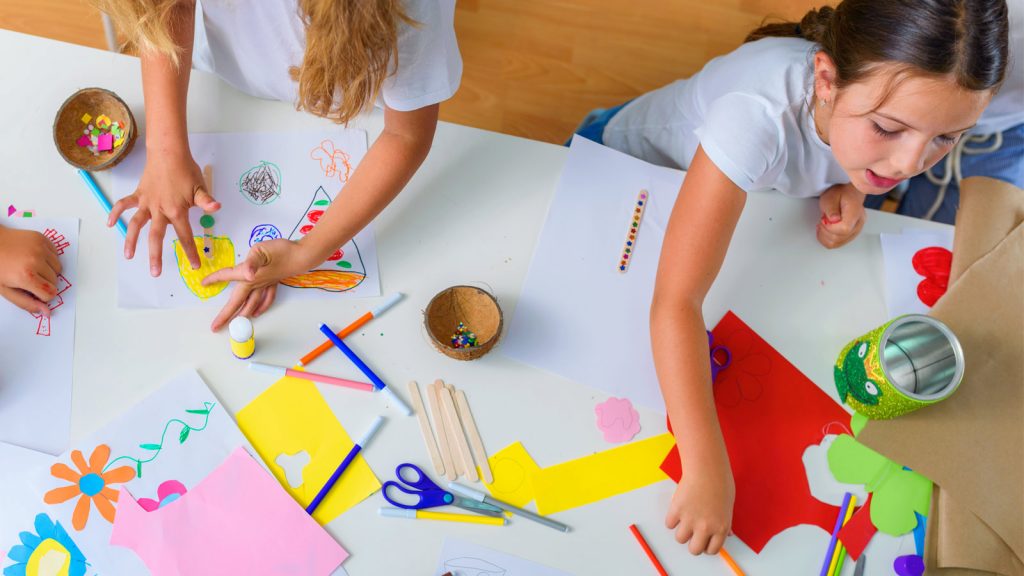Developing fine motor skills is an important part of every young child’s development.
Fine motor skills refer to controlling the small movements of muscles in hands and fingers that people use to perform everyday tasks, like pinching your fingers together or grabbing a small object.[1]
Here we’ll explore why fine motor skills are important, plus give you some activities to do at home to help your child develop them.
Why Are Fine Motor Skills Important?
It’s important for children to practice their fine motor skills so they can have a solid foundation as they grow up for everyday activities like:
- Getting dressed (with snaps zippers, and shoelaces)
- Using utensils to eat
- Opening and closing things
- Holding a pen or pencil
- Using a computer mouse or keyboard[1]
Plus, developing of fine motor skills also benefits children by improving hand-eye coordination, fostering independence and confidence, and promoting cognitive development.[2]
Some children may not develop fine motor skills at exactly the same time as their peers. Usually that’s no reason for concern—children develop at different paces. But sometimes fine motor delays can be associated with developmental issues. Your pediatrician is the best person to talk to if you have questions or concerns about fine motor skill development in your child.
40 Activities You Can Do With Your Child to Develop Fine Motor Skills
Fortunately, fine motor skills can be strengthened using things you already have around the house. Here are some free or very low-cost activities and ideas for building fine motor skills in your toddler or preschooler.
1. Being able to grip a pencil properly is an important skill. Here’s a printable from Waterford Mentor to illustrate proper grip.
2. Here are some ways children can practice gripping a pencil.
3. With a pencil or crayon, practice tracing lines. Here’s a free tracing printable from Waterford Mentor.
4. Big, chunky sidewalk chalk is great for young children to grasp on to. On a nice day, head outside and use the sidewalk chalk to make some art.
5. Play with play dough. You can make your own for pennies.
6. Let your child open and close plastic containers with lids.
7. Practice using a zipper.
8. Practice with buttons and snaps on a piece of clothing.
9. Practice pouring things: put rice or beads in a small container, and have your child pour them into an identical empty container.
10. Cut out and order these sentence builders from Waterford Mentor to practice using scissors.
11. Threading is a great fine motor skill builder. Using dry rigatoni or other large macaroni shape and some yarn or ribbon. String the ribbon through the pasta. Note: you’ll need to tie the first piece to the string so the rest won’t slide off.
12. Another threading idea: Put some drinking straws upright in play dough and have your child thread pasta through them to build pasta towers.
13. Handling safety scissors is good fine motor exercise, and a necessary skill for school. Waterford Mentor has many cut-out activities, including this one for sorting shapes.
14. This window art activity uses clear contact paper. Unroll the contact paper and tape the edges to a table, sticky side up. Have your child cut shapes from colorful paper and stick them to the paper. When they’re done, you have pretty window art.
15. Have your child “help” you clean up around the house (yeah, you’ll probably have to go back and re-clean everything later). They’ll enjoy the time with you, and they can learn tasks like grasping a sponge, setting a table, or putting things away.
16. Finger Painting is good, messy, easy-to-clean fun that encourages artistic and motor skill development.
17. After finger painting, the next step is grasping a paintbrush for painting. Try some water colors.
18. Grab some free printable coloring pages from your pals Rusty and Rosy for practice grasping crayons, paintbrushes, or colored pencils.
19. Hand puppets promote fine motor skills and fire up the imagination. Use brown paper lunch sacks and make your own.
20. Download patterns like this elephant or pig puppet to color and glue to a sack for puppet story time.
21. Pipe cleaners are a great, low-cost craft material. Grab a pasta colander and thread the pipe cleaners through the holes to build fine motor skills and develop hand-eye coordination with an activity that will keep them busy.
22. Poke holes in a cardboard box for your child to squeeze pipe cleaners through.
23. Grab some clothespins and pipe cleaners and have your child squeeze the clothespins onto the pipe cleaners.
24. Your child can practice lacing, an important skill, with yarn or ribbon on cardboard or cardstock shapes.
25. Find dozens more pipe cleaner activities here.
26. Another easy-to-find craft item, popsicle sticks, are tailor-made for developing fine motor skills for busy children. Here’s an idea using a mason jar and popsicle sticks for some engaging play.
27. Here’s a video with six more popsicle stick activities.
28. Download and print these free dinosaur puppets from Waterford Mentor. Have your child cut out the figures, color them, and glue popsicle sticks to them for some puppet play.
29. Take an empty egg carton and use paint or construction paper to color the bottom of the cups, then cut slits through them. Match colored popsicle sticks to the egg carton colors by pushing the sticks through the carton.s
30. Grab a roll of masking or painter’s tape and tape some strips to a table. Leave a little bit sticking up for younger children, or tape it all the way down for older children, then let them enjoy unpeeling the tape.
31. Here’s a “rescue” game that uses a muffin tin, painter or masking tape, and small toys. Have your child retrieve the toys by cutting through the tape.
32. Keep that muffin tin and grab a spatula and some small blocks. Your child can practice using the spatula to pick up blocks and drop them in the muffin tin.
33. Fill some containers with water and grab a turkey baster or medicine syringe. Let your child explore using the baster to move water from one container to another.
34. Here’s a fun water pouring station for outside (for added fun, you can use food coloring to tint the water). Your child will enjoy pouring water from one container to another.
35. Use dyed rice or rock salt (easy to make beforehand) and use a spoon to fill rainbow jars and make pretty patterns.
36. An alternative to dying rice or salt is to simply use different types of dried beans and lentils in a jar to create colorful patterns.
37. Simply peeling bananas or oranges, and other fun activities, are everyday ways to build fine motor skills.
38. Wrapping rubber bands around a tin can is a fun and zero-setup activity to build fine motor skills.
39. Seashells and play sand are great for learning the alphabet in this motor skills activity!
40. Use sand and small rocks along with play animals for an animal maze activity.
Sources:
- Moyses, Kendra. “Building Fine Motor Skills and Why it Matters.” Michigan State University Extension. June 2016. https://www.canr.msu.edu/news/building_fine_motor_skills_and_why_it_matters
- University of St. Augustine for Health Sciences. “How to Improve Fine Motor Skills.” June 2020. https://www.usa.edu/blog/how-to-improve-fine-motor-skills/

